The Cream Separator Market is estimated to be valued at USD 627.4 million in 2025 and is projected to reach USD 1081.8 million by 2035, registering a compound annual growth rate (CAGR) of 5.6% over the forecast period.
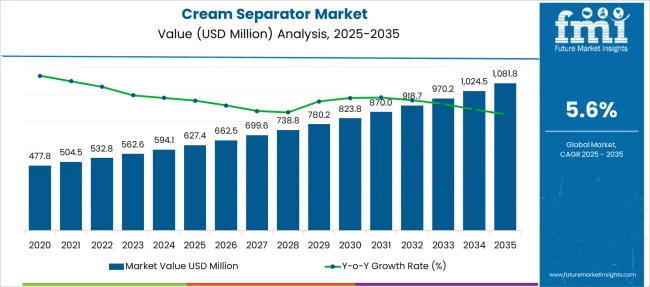
| Metric | Value |
|---|---|
| Cream Separator Market Estimated Value in (2025 E) | USD 627.4 million |
| Cream Separator Market Forecast Value in (2035 F) | USD 1081.8 million |
| Forecast CAGR (2025 to 2035) | 5.6% |
The Cream Separator market is experiencing notable growth as dairy producers and food processing industries prioritize efficiency, hygiene, and automation in milk processing operations. Increased global demand for dairy products and advancements in milk standardization technology are supporting the shift toward modern separation systems. The adoption of automated cream separators is being influenced by the growing scale of dairy operations and the rising need for consistent quality across production batches.
Press releases and annual communications from dairy equipment manufacturers have highlighted how technological innovation, particularly in motor efficiency and hygienic design, is enabling cost-effective and high-volume cream extraction. Emerging markets are also contributing to growth, with government-led programs promoting mechanized dairy infrastructure.
In developed regions, compliance with food safety regulations and the demand for low-fat dairy products are further reinforcing investment in advanced separation equipment These drivers are positioning the market for continued expansion, driven by both operational necessity and regulatory alignment in the global dairy processing sector.
The market is segmented by Product and Application and region. By Product, the market is divided into Power-driven Separator, Semi-enclosed Separator, Hand-driven Separator, Open Bowl Separator, and Self-cleaning Separator. In terms of Application, the market is classified into Industrial, Commercial, and Other Facilities. Regionally, the market is classified into North America, Latin America, Western Europe, Eastern Europe, Balkan & Baltic Countries, Russia & Belarus, Central Asia, East Asia, South Asia & Pacific, and the Middle East & Africa.
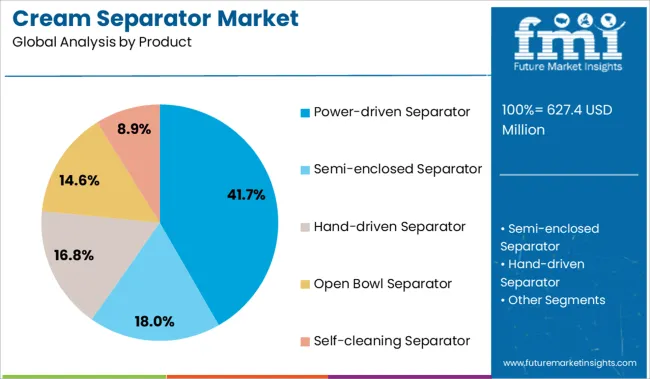
The power-driven separator segment is projected to account for 41.7% of the Cream Separator market revenue share in 2025, making it the leading product segment. This dominance is being attributed to the growing industrialization of dairy processing and the increasing need for automation in cream extraction. Power-driven units are being preferred due to their ability to handle large volumes of milk with consistent speed and minimal manual intervention.
As noted in equipment manufacturer announcements and industry publications, their energy-efficient designs and precision controls have made them suitable for both small-scale cooperatives and large-scale plants. The reduced labor dependency and improved hygiene compliance have also supported the segment’s expansion, especially in regions focused on modernizing dairy infrastructure.
The segment’s growth is being further strengthened by improvements in motor technology and easy-to-maintain modular components that lower downtime and operational costs These advantages are positioning power-driven separators as a reliable and scalable solution for contemporary dairy operations.
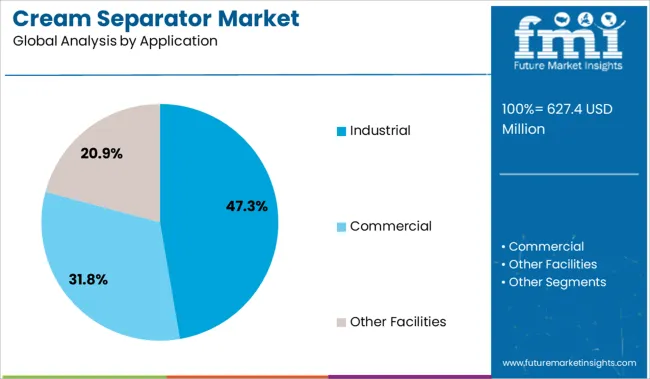
The industrial application segment is expected to hold 47.3% of the Cream Separator market revenue share in 2025, establishing it as the dominant application segment. This leadership is being supported by the widespread use of cream separators in large-scale dairy processing units and food manufacturing facilities. As identified in trade publications and processing equipment catalogs, industrial users are increasingly adopting automated separation systems to meet the rising demand for uniform milk fat content and regulatory compliance.
The capacity to process large milk volumes efficiently while maintaining hygiene standards has made industrial cream separators a preferred choice among manufacturers. Demand has also been reinforced by the segment’s role in ensuring product consistency, reducing waste, and optimizing processing time.
Additionally, industrial operators have favored these systems for their ability to integrate with broader production lines and support continuous operation These drivers have collectively contributed to the segment’s leading market position in 2025.
As per FMI, the global cream separator market witnessed steady growth at a CAGR of 4.2% during the historical period from 2020 to 2025. The rising use of cream separators by dairy product manufacturing companies for the production of milk, ghee, and butterfat is one of the most significant factors pushing sales in the global market.
The market for cream separators is projected to grow faster than average due to the rapid expansion of the global dairy processing industry. Automatic and semi-automatic cream separators are expected to be mainly utilized by key companies in the market.
Conventional cream separators made use of gravity, however, today’s innovative devices are based on the principle of centrifugal force. By using centrifugal separation, one can produce creams of three different types, namely, heavy, light, and plastic cream. Owing to the aforementioned factors, the global cream separator market is anticipated to showcase growth at a CAGR of 5.6% during the forecast period.
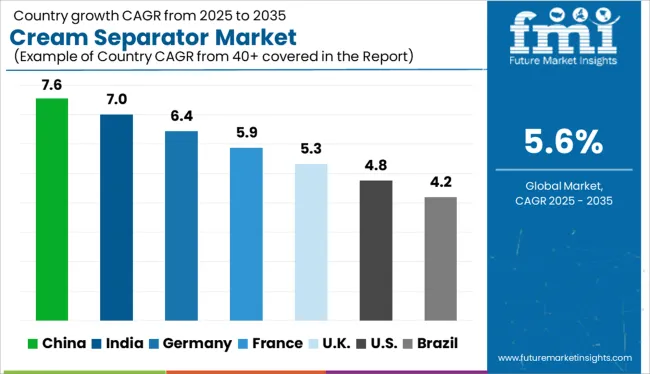
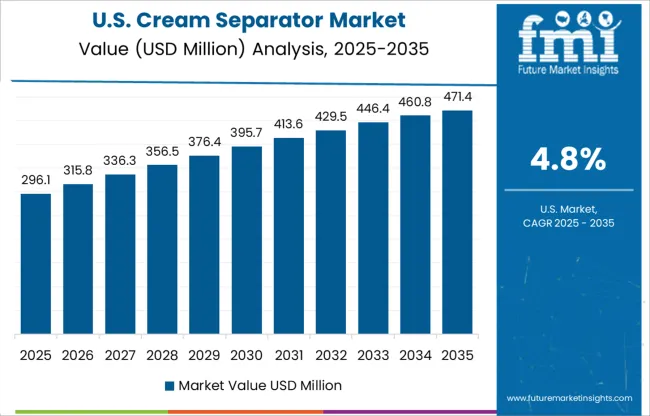
Availability of No-sugar Milk in the USA to Push Sales of Centrifuge Machines by 2035
According to FMI, the USA cream separator market is expected to grow at a CAGR of 68% during the forecast period. The market is estimated to create an absolute dollar opportunity of nearly USD 627.4 million from 2025 to 2035. High consumption of butter and cheese in the country is set to drive the market in the next ten years. Innovations in the field of the dairy industry such as the emergence of no-sugar or low-fat milk, are also expected to aid growth in the USA.
India to Witness the Entry of Various Small-scale Dairy Equipment Manufacturers
Due to the rapidly rising population and increased demand for dairy products manufactured from cream, cream separators are in high demand in India. This further compels medium- and small-sized companies to partake in the cream separator market. Major players in the country are looking to establish their presence in the Indian market, with robust distribution channels to improve access to the local industry.
Milk Processing Equipment Firms in China to Provide Innovative Devices by 2035
According to FMI, the cream separator market in China is set to witness growth at a CAGR of 32% during the assessment period. The country is estimated to create an incremental opportunity of nearly USD 32.4 million from 2025 to 2035. Rising government support to expand the country’s dairy industry and the presence of several international dairy product manufacturers are anticipated to create a positive impact on the China cream separator market.
Japan-based Milk Cream Separator Machine Manufacturers to Come up with Unique Devices
During the projected period, the Asia Pacific cream separator market is expected to grow at a CAGR of 18% and is likely to be valued at USD 1081.8 million by the end of 2035. Various Japan-based manufacturers of cream separators are using novel tools to develop new devices for catering to the high demand in the country. This factor is projected to boost the Asia Pacific market in the next ten years.
High Demand for Packaged Dairy Products to Boost Sales of Milk Cream Machines in the UK
According to FMI, the UK cream separator market is projected to witness growth at a CAGR of 22% in the next ten years. The UK is considered to be a lucrative market for cream separators with the presence of various local and international players. Surging demand for packaged and quality dairy products is also estimated to drive the market. Thus, the UK is anticipated to reach a valuation of around USD 49.5 Million in the evaluation period.
Electric Cream Separators to Be Extensively Used for Commercial Milk Production
Based on application, the commercial segment is projected to remain at the forefront in the next ten years by generating the largest cream separator market share. Rising milk consumption across the globe, especially in developing countries, owing to its high calcium and protein content is anticipated to propel the segment. Besides, milk consumption has proved to lower the risk of osteoporosis among the geriatric population, which is likely to fuel the segment.
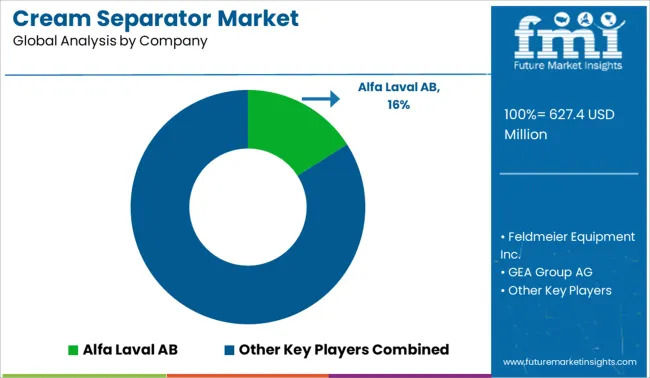
The cream separator market is highly fragmented with the presence of various global and regional players. Major players around the world are focusing on the development of cost-effective cream separators to meet the high demand from end-use industries. In addition, many renowned players are providing customized solutions to satisfy the needs of their customers.
Among the leading players, Alfa-Laval provides a large number of cream separation solutions that combine increased efficiency and robust reliability with low total lifecycle costs. Tetra Pak, on the other hand, launched airtight expertise, thereby enabling superior separation productivity and a separator designed for supreme flexibility in both capacity and method range.
For instance:
| Attribute | Details |
|---|---|
| Estimated Market Size (2025) | USD 627.4 million |
| Projected Market Valuation (2035) | USD 1081.8 million |
| Value-based CAGR (2025 to 2035) | 5.6% |
| Forecast Period | 2025 to 2035 |
| Historical Data Available for | 2020 to 2025 |
| Market Analysis | Value (USD Million) |
| Key Regions Covered | North America; Latin America; Europe; Asia Pacific; Oceania; Middle East & Africa (MEA) |
| Key Countries Covered | The US, Canada, Mexico, Germany, The UK, France, Italy, Spain, China, Japan, India, South Korea, Australia, Brazil, Argentina, South Africa, UAE |
| Key Segments Covered | ProductOperationb, Application, Region |
| Key Companies Profiled | Alfa-Laval-Ab; Feldmeier Equipment Inc.; GEA Group; Krones AG; Marlen International Inc.; Paul Mueller Company; Tetra Pak; SPX Flow; ADMIX; IDMC |
| Report Coverage | Market Forecast, Company Share Analysis, Competitive Landscape, DROT Analysis, Market Dynamics and Challenges, and Strategic Growth Initiatives |
The global cream separator market is estimated to be valued at USD 627.4 million in 2025.
The market size for the cream separator market is projected to reach USD 1,081.8 million by 2035.
The cream separator market is expected to grow at a 5.6% CAGR between 2025 and 2035.
The key product types in cream separator market are power-driven separator, _high-speed separator, _middle-speed separator, _low-speed separator, semi-enclosed separator, hand-driven separator, open bowl separator and self-cleaning separator.
In terms of application, industrial segment to command 47.3% share in the cream separator market in 2025.






Full Research Suite comprises of:
Market outlook & trends analysis
Interviews & case studies
Strategic recommendations
Vendor profiles & capabilities analysis
5-year forecasts
8 regions and 60+ country-level data splits
Market segment data splits
12 months of continuous data updates
DELIVERED AS:
PDF EXCEL ONLINE
Cream of Tartar Market Size and Share Forecast Outlook 2025 to 2035
Cream Cheese Market Analysis – Size, Share, and Forecast 2025 to 2035
BB Cream Market Analysis by Skin Type, SPF Type, End Uses, Sales Channel and Region through 2025 to 2035
Ice Cream Coating Market Size and Share Forecast Outlook 2025 to 2035
Ice-cream Premix and Stabilizers Market Size and Share Forecast Outlook 2025 to 2035
Ice Cream Equipment Market Size and Share Forecast Outlook 2025 to 2035
Analysis and Growth Projections for Ice Cream and Frozen Dessert Market from 2025 to 2035
Ice Cream Packaging Market - Outlook 2025 to 2035
Ice Cream Processing Equipment Market Growth - Trends, Demand & Innovations 2025 to 2035
Ice Cream Service Supplies Market - Premium Serving Essentials 2025 to 2035
Ice Cream Parlor Market Analysis by Type, Product Type, and Region Through 2035
Breaking Down Market Share in the Ice Cream Parlor Industry
Ice Cream Container Market Size & Trends Forecast 2024-2034
Dry Cream Substitute Market
Ice-cream Maker Market
Precis of Key Trends Shaping Sour Cream Powder Business Landscape.
DMAE Cream Market Report – Growth & Industry Trends 2024-2034
A2 Ice Cream Market Size and Share Forecast Outlook 2025 to 2035
Coffee Creamer Market Analysis by Form, Nature, Category, Application and Sales Channel Through 2025 to 2035
Firming Creams and Serums Market Analysis - Size and Share Forecast Outlook 2025 to 2035

Thank you!
You will receive an email from our Business Development Manager. Please be sure to check your SPAM/JUNK folder too.
Chat With
MaRIA